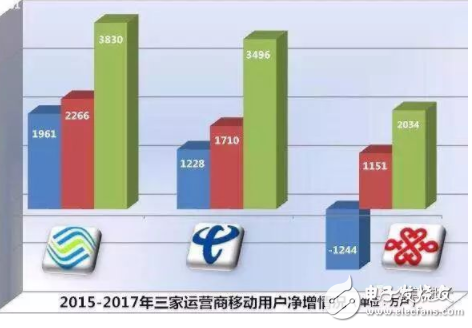The industry has rumored that the size of mobile communication users has reached the ceiling, and the so-called demographic dividend has disappeared. However, after 2017, this statement is no longer accurate. The three operators have achieved the best results in the past three years.
Recently, China Mobile, China Telecom and China Unicom have announced the business development in 2017. Through data comparison, people are surprised to find that the “demographic dividend has disappeared!†“The size of mobile communication users touched the ceiling!†These assertions are simply untenable in 2017.

In 2017, the three operators' annual net increase in the number of users has achieved the best results in the past three years. This phenomenon is quite rare, especially the net increase of China Telecom's net users.
The reason why the growth of domestic mobile users can open up new space, in the view of some industry insiders, is because the operator’s second card slot and sub-card strategy have become effective, making “one-family multi-card†a common phenomenon and promoting mobile users. The speed is obviously faster.
In the past few years, it has been said that "the scale of mobile communication users touched the ceiling" is true. This is indeed the case.
From 2010 to 2013, China Mobile Communications has developed very rapidly. In the past four years, the number of net users per year has exceeded 100 million, which has pushed the scale of mobile users in China to a new level.
However, in 2014, the growth of domestic mobile users declined in a cliff-like manner. The number of mobile users that increased netly this year was 56.98 million, less than half of the previous year. In the following years, 2015 and 2016, the growth rate of domestic mobile users is still showing a weak trend. Even in some places, the scale of mobile users has not only not increased, but has declined. For example, in areas with relatively developed economic development such as Shanghai, Jiangsu, Guangdong, and Zhejiang, the number of mobile users has not been lost. In 2016, the number of mobile phone users in Guangdong decreased by 6.6 million, and that of Jiangsu decreased by 290,000. .
By 2017, the situation has changed dramatically. The net increase in mobile subscribers of the three operators in 2017 has reached a new high in 2014, and there has been a significant increase compared with 2016.
China Telecom added 34.96 million mobile subscribers in 2017, compared with 17.1 million and 12.28 million in 2016 and 2015, respectively. China Mobile's net increase in mobile subscribers in 2017 was 38.3 million, higher than the net increase of 22.66 million in 2016 and 19.61 million in 2015. China Unicom's net increase in mobile subscribers in 2017 was 20.34 million, which was also higher than the 11.51 million in 2016 and the 12.44 million in 2015.
Compared with the net increase in 2016, China Telecom's net increase in 2017 increased by 104.4% year-on-year, China Mobile increased by 69% year-on-year, and China Unicom increased by 76.7% year-on-year.
In addition, those regions where mobile users fell in size in 2016 regained growth in 2017. For example, in 2017, the number of mobile users in Guangdong increased by 4.47 million, and that in Jiangsu Province increased by 6.09 million.
Time to move"China Telecom's mobile subscribers have grown by more than 16% from the end of the previous year. This has not been seen for many years. China Mobile and China Unicom are also growing at a high speed. With the second card slot and sub-card strategy of operators, the growth rate of mobile users is obvious. Speed ​​up." Fu Liang, an independent analyst in the telecommunications industry.

In the past, the increase in the scale of mobile users hit the ceiling and the demographic dividend disappeared because a user in the past was basically only a user of an operator. This is because, after being affected by factors such as the communication tariff level and the mobile terminal, if a user selects the service of an operator, it will not select the mobile communication service of other operators at the same time. Therefore, when the penetration rate of mobile phone users is getting higher and higher, the incremental market of operators is becoming smaller and smaller.
However, the market environment has changed dramatically. On the one hand, under the vigorous promotion of “speed-up and fee reduction†in these years, the communication tariff level has been continuously reduced. In the past, the cost of using a mobile phone card by users can now use two or three mobile phone cards. On the other hand, the popularity of all Netcom mobile phones has also reduced the cost of using multiple mobile phone cards. With the vigorous promotion of China Telecom and China Unicom and the encouragement of government departments, it is now mainstream in the market to be compatible with all network standards of all three operators, and to use full-network mobile phones with different operators' 4G networks through convenient switching.
In 2017, the sales volume of all Netcom mobile phones in the whole industry has exceeded 75%. In the past, if the operator of this carrier wanted to use the mobile phone card of other operators, it also needs to purchase the corresponding mobile phone terminal, and the cost restricts the user's choice.
Stimulated by positive factors such as speed-up and fee-reduction, and the popularity of mobile phones across the Netcom, “one-to-one card†has become a very common phenomenon. One user, either the user of this operator or another user, opens up new space for the growth of domestic mobile users.
China Telecom and China Unicom have achieved good results in the growth of 4G users.
In 2017, China Telecom added a net increase of 60.17 million 4G users for the whole year, surpassing 60 million for the second consecutive year. China Telecom's 4G subscriber market share has jumped from 7.1% in 2014 to 18.1%, an increase of 11 percentage points in three years.
China Unicom posted a net increase of 70.33 million 4G users in 2017, an increase of 16.4% compared to 2016. China Unicom's rapid growth in 4G users has benefited a lot from Internet mobile phone cards, especially the Wang card that it launched in cooperation with Tencent. It is reported that the number of Wangka users has exceeded 50 million.
In 2017, China Mobile accumulated a net increase of 114 million 4G users. Although this figure is still the highest among the three operators, the vertical comparison will find that only about half of the previous two years is a cliff-like decline. At present, the domestic 4G development has entered the second half as a whole. With the continuous improvement of the penetration rate, the new space is getting smaller and smaller. At the same time, under the active attack of the other two operators, China Mobile is under increasing pressure in the 4G new market.

In the first eleven months of 2017, China Unicom had a net increase of 2.267 million broadband users, which added to the loss of nearly half (964,000) in December. This led to the increase of 1.303 million cable broadband subscribers in China Unicom in 2017, setting the lowest value since the disclosure of operational data in 2008.
China Mobile continued to rush in the cable broadband market in 2017, with a net increase of 3.5.63 million subscribers in the year, a significant increase of 55% compared to 2016.
With the all-round competitive advantage of end-to-end network, service and converged operation, the number of broadband subscribers in China Telecom in 2017 has further increased to 153 million, and continues to maintain its leading position in the broadband market. Among them, China Telecom's listed subsidiaries have 134 million broadband subscribers in their cable broadband service areas, and net subscribers have exceeded 10 million subscribers for the second consecutive year, reaching a record high in five years.
3500 puffs disposable vape pen are so convenient, portable, and small volume, you just need to take them
out of your pocket and take a puff, feel the cloud of smoke, and the fragrance of fruit surrounding you. It's so great.
We are China's leading manufacturer and supplier of disposable vape puff bars,3500 puff vape bar,3500 puff vape rechargeable,
3500 puffs disposable vape,disposable vape bars 3500 puffs, and e-cigarette kit, and we specialize in Disposable Vapes,
e-cigarette vape pens, e-cigarette kits, etc.
3500 puff vape bar,3500 puff vape rechargeable,3500 puffs disposable vape,3500 puffs vape pen,disposable vape bars 3500 puffs
Ningbo Autrends International Trade Co.,Ltd. , https://www.supermosvape.com